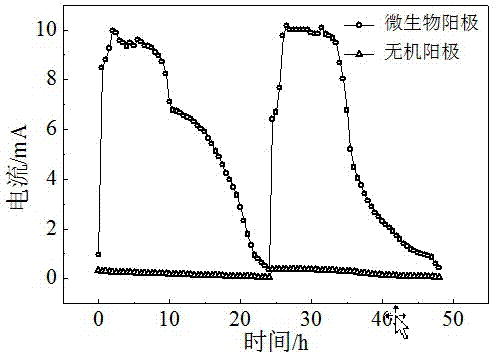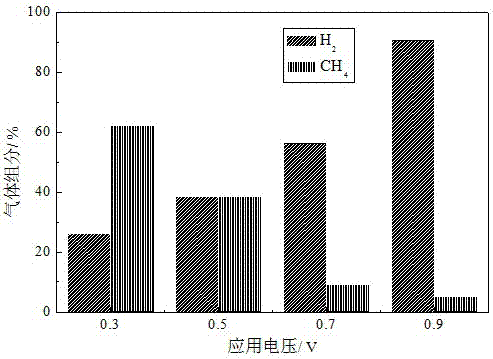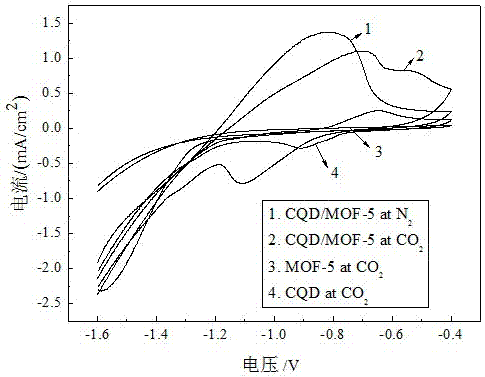Microorganism-assisted CO2 photoelectrocatalysis reduction method
A photoelectric catalysis and microbial technology, applied in chemical instruments and methods, biological water/sewage treatment, electrochemical and biological combination treatment, etc., can solve the problems of high energy consumption in hydrogen evolution reaction competition, poor carbon fixation performance of the reaction system, poor product selectivity, etc. problem, to achieve the effect of wide response range of visible light, inhibition of competitive hydrogen evolution reaction, and good conductivity
- Summary
- Abstract
- Description
- Claims
- Application Information
AI Technical Summary
Problems solved by technology
Method used
Image
Examples
Embodiment 1
[0027] Use a carbon cloth with a size of 5 cm×2 cm as the anode substrate. First rinse with plenty of water, and then sonicate it in four solutions of acetone, deionized water, ethanol, and deionized water for 20 minutes, and then in 1 mol / L Soak in HCl and 1 mol / L NaOH for 2 hours respectively to remove impurities on the surface of the electrode material, then rinse with a large amount of deionized water, soak in deionized water for 5 hours, change the water, and repeat three times. Select 25 mL of aerobic activated sludge as the bacteria source to inoculate the anode compartment of the microbial fuel cell, add 100 mL of brewery wastewater as the culture solution, and prepare the N-doped graphene quantum dots (NGQD) / MOFs composite as the cathode , With 1 mol / LNaHCO containing 25% volume fraction of 1-butyl-3-methylimidazole tetrafluoroborate ionic liquid 3 Aqueous solution as binary catholyte, CO 2 It is the cathode electron acceptor, with an external 3000 Ω resistor, and the m...
Embodiment 2
[0029] Use a carbon felt with a size of 4cm×2cm as the anode substrate. First rinse with a lot of water, and then sonicate for 20 minutes in four solutions of acetone, deionized water, ethanol, and deionized water, and then in 1 mol / L HCl and Soak in 1 mol / L NaOH for 2 hours to remove impurities on the surface of the electrode material, then rinse with a large amount of deionized water, soak in deionized water for 5 hours, change the water, and repeat three times. Select 20 mL of digested sludge as the bacteria source to inoculate the anode compartment of the microbial fuel cell, and add 80 mL of domestic sewage as the culture solution to prepare the graphene / g-C 3 N 4 / MOFs composite material as the cathode, prepared with 1 mol / L NaHCO containing 35% volume fraction of 1-butyl-3-methylimidazole hexafluorophosphate ionic liquid and 25% volume fraction of acetonitrile 3 Aqueous solution as ternary catholyte, CO 2 It is the cathode electron acceptor, with an external 2000 Ω resisto...
Embodiment 3
[0031] Use a graphite rod with a diameter of 1 cm and a length of 15 cm as the anode substrate. First rinse with a large amount of water, and then sonicate it in four solutions of acetone, deionized water, ethanol, and deionized water for 20 minutes, and then at 1 mol / Soaked in L HCl and 1 mol / L NaOH for 2 h respectively to remove the surface impurities of the electrode material, then rinsed with a large amount of deionized water, soaked in deionized water for 5 h, changed the water, and repeated three times. Select 15 mL of anaerobic activated sludge as the bacteria source to inoculate the anode compartment of the microbial fuel cell, and add 80 mL of domestic sewage as the culture solution to prepare the graphene / g-C 3 N 4 / MOFs composite material is the cathode, which has been prepared containing 30% volume fraction of 1-butyl-3-methylimidazole hexafluorophosphate ionic liquid and 25% volume fraction of 1 mol / L KHCO of chloroform 3 Aqueous solution as ternary catholyte, CO 2 ...
PUM
| Property | Measurement | Unit |
|---|---|---|
| diameter | aaaaa | aaaaa |
| length | aaaaa | aaaaa |
| diameter | aaaaa | aaaaa |
Abstract
Description
Claims
Application Information
 Login to View More
Login to View More - R&D
- Intellectual Property
- Life Sciences
- Materials
- Tech Scout
- Unparalleled Data Quality
- Higher Quality Content
- 60% Fewer Hallucinations
Browse by: Latest US Patents, China's latest patents, Technical Efficacy Thesaurus, Application Domain, Technology Topic, Popular Technical Reports.
© 2025 PatSnap. All rights reserved.Legal|Privacy policy|Modern Slavery Act Transparency Statement|Sitemap|About US| Contact US: help@patsnap.com



